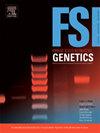Profiling microRNA expression differentiates monozygotic twins in peripherical blood by droplet digital PCR
IF 3.1
2区 医学
Q2 GENETICS & HEREDITY
引用次数: 0
Abstract
It is challenging to distinguish monozygotic (MZ) twins using traditional autosomal STR genotyping due to their nearly identical genomes. As an important kind of small non-coding RNAs, microRNAs (miRNAs) are essential regulators of gene expression and considered as excellent biomarkers due to their resistance to degradation. Moreover, droplet digital PCR (ddPCR) has emerged as a powerful technique for detecting gene mutations and pathogenic microorganisms, owing to its sensitivity and reliability. We aimed to explore the differential expression of miRNAs between MZ twins using next-sequence platform and assess the reliability of differentially expressed miRNAs by ddPCR. MiRNA sequencing (miRNA-seq) revealed nine differentially expressed miRNAs shared across five pairs of twins, including hsa-miR-3620-3p, hsa-miR-6825-5p, hsa-miR-1273h-5p, hsa-miR-200a-5p, hsa-miR-3192-5p, hsa-miR-188-5p, hsa-miR-206, hsa-miR-4796-5p, and hsa-miR-6775-3p. Subsequently, the combination of real-time quantitative PCR (qPCR) and ddPCR confirmed the ability of five of these miRNAs (hsa-miR-1273h-5p, hsa-miR-3192-5p, hsa-miR-188-5p, hsa-miR-206, and hsa-miR-6775-3p) in distinguishing monozygotic twins. Furthermore, ddPCR demonstrated superior recognition accuracy compared to qPCR. Finally, we evaluated the degradation resistance of these five miRNAs under different environmental conditions. None of the five miRNAs showed a significant decrease in expression levels after being stored at room temperature for up to 180 days or undergoing 10 freeze-thaw cycles. In summary, our study revealed the potential application of miRNAs in differentiation of MZ twins and the powerful role of ddPCR in forensic medicine.
用微滴数字PCR分析外周血中同卵双胞胎的microRNA表达。
由于同卵双胞胎的基因组几乎相同,使用传统的常染色体STR基因分型来区分同卵双胞胎是具有挑战性的。microRNAs (miRNAs)是一类重要的非编码小rna,是基因表达的重要调控因子,因其抗降解性被认为是优秀的生物标志物。此外,由于其灵敏度和可靠性,液滴数字PCR (ddPCR)已成为检测基因突变和致病微生物的有力技术。我们的目的是利用下一序列平台探索MZ双胞胎之间miRNAs的差异表达,并通过ddPCR评估差异表达miRNAs的可靠性。MiRNA测序(MiRNA -seq)揭示了五对双胞胎共有的九种差异表达的MiRNA,包括hsa-miR-3620-3p, hsa-miR-6825-5p, hsa-miR-1273h-5p, hsa-miR-200a-5p, hsa-miR-3192-5p, hsa-miR-188-5p, hsa-miR-206, hsa-miR-4796-5p和hsa-miR-6775-3p。随后,实时定量PCR (qPCR)和ddPCR联合证实了其中5种miRNAs (hsa-miR-1273h-5p、hsa-miR-3192-5p、hsa-miR-188-5p、hsa-miR-206和hsa-miR-6775-3p)区分同卵双胞胎的能力。此外,与qPCR相比,ddPCR表现出更高的识别准确性。最后,我们评估了这5种mirna在不同环境条件下的降解抗性。在室温下保存长达180天或进行10次冻融循环后,5种mirna的表达水平均未出现显著下降。总之,我们的研究揭示了mirna在MZ双胞胎分化中的潜在应用以及ddPCR在法医学中的强大作用。
本文章由计算机程序翻译,如有差异,请以英文原文为准。
求助全文
约1分钟内获得全文
求助全文
来源期刊
CiteScore
7.50
自引率
32.30%
发文量
132
审稿时长
11.3 weeks
期刊介绍:
Forensic Science International: Genetics is the premier journal in the field of Forensic Genetics. This branch of Forensic Science can be defined as the application of genetics to human and non-human material (in the sense of a science with the purpose of studying inherited characteristics for the analysis of inter- and intra-specific variations in populations) for the resolution of legal conflicts.
The scope of the journal includes:
Forensic applications of human polymorphism.
Testing of paternity and other family relationships, immigration cases, typing of biological stains and tissues from criminal casework, identification of human remains by DNA testing methodologies.
Description of human polymorphisms of forensic interest, with special interest in DNA polymorphisms.
Autosomal DNA polymorphisms, mini- and microsatellites (or short tandem repeats, STRs), single nucleotide polymorphisms (SNPs), X and Y chromosome polymorphisms, mtDNA polymorphisms, and any other type of DNA variation with potential forensic applications.
Non-human DNA polymorphisms for crime scene investigation.
Population genetics of human polymorphisms of forensic interest.
Population data, especially from DNA polymorphisms of interest for the solution of forensic problems.
DNA typing methodologies and strategies.
Biostatistical methods in forensic genetics.
Evaluation of DNA evidence in forensic problems (such as paternity or immigration cases, criminal casework, identification), classical and new statistical approaches.
Standards in forensic genetics.
Recommendations of regulatory bodies concerning methods, markers, interpretation or strategies or proposals for procedural or technical standards.
Quality control.
Quality control and quality assurance strategies, proficiency testing for DNA typing methodologies.
Criminal DNA databases.
Technical, legal and statistical issues.
General ethical and legal issues related to forensic genetics.

 求助内容:
求助内容: 应助结果提醒方式:
应助结果提醒方式:


